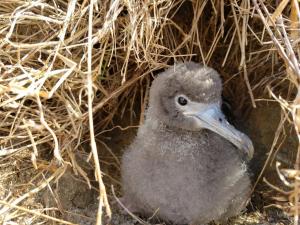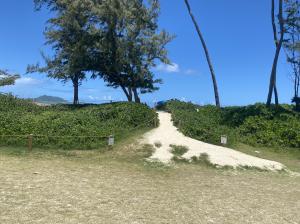Seabirds successfully nesting in Oʻahu neighborhoods
University of HawaiʻiGraduate Student, College of Tropical Agriculture and Human Resource
Mark Berthold, 808-343-4569
Director, Communication Svcs, College of Tropical Agriculture and Human Resource
ʻUaʻu kani, or wedge-tailed shearwater, is a seabird species common in Hawaiʻi. Though historically found nesting along coastlines, human development in these areas has likely reduced the availability of nesting habitats, pushing the seabird colonies to nest in undeveloped islets.
However, many coastal residents continue to observe ʻuaʻu kani nesting nearby—or on their properties—where they are unprotected and threatened by nest trampling due to human activity or construction; predation by rats, cats, mongoose and dogs; and potentially, stress caused by proximity to human activity.
Surprisingly, a University of Hawaiʻi at Mānoa study “Wedge-tailed Shearwater (Ardenna pacifica) nesting success in human-dominated coastal environments,” from the Department of Natural Resources and Environmental Management (NREM) in the College of Tropical Agriculture and Human Resources, found no significant difference in nesting success of the wedge-tailed shearwater at an unprotected, popular beach park versus a site with restricted public access.
“Though nesting success at Kailua Beach Park was slightly lower than nesting success at the restricted-access site, it seems so long as their underground nests aren’t trampled and collapsed, and no major predation events occur, colonies in busy beach parks can be successful,” said Jessica Idle, a graduate student in NREM’s Hawaiʻi Wildlife Ecology Lab.
Adding “symbolic fencing”
Still, their conclusions have convinced stakeholders to construct “symbolic fencing” around the seabird colony at Kailua Beach Park to encourage park-goers to avoid walking through the nesting areas.
“We thank the City and County of Honolulu Department of Parks and Recreation, for their support and permission allowing us to install signage and symbolic fencing at the Kailua wedge-tailed shearwater colony,” said Jon Gelman of Hawaiʻi Marine Animal Response, which constructed the fence. “We also thank the University of Hawaiʻi, Hawaiʻi Pacific University and the U.S. Fish and Wildlife Service Pacific Islands Coastal Program for their collaboration and support of our seabird conservation projects.”
Stephanie Araki of the Honolulu City and County’s Department of Recreation, added, “Kudos to Ms. Idle and her colleagues for their commitment to protect our precious wildlife and to teach the rest of us about our seabird ‘ohana. We are honored to have played an insignificant role in this significant study and hope that the protective fences enable the wedge-tailed shearwaters to survive and return to their Kailua home for many years to come.”
Residents can help
NREM and its partners hope to encourage Hawaiʻi residents with seabirds nesting in their neighborhoods, local parks and back yards to consider similar temporary fencing and signage.
“Further steps that everyone can take include keeping dogs leashed near nesting colonies, minimizing noise and activity near colonies at dawn and dusk when the adult birds are coming and going from the nests, and turning off indoor and outdoor lights in November and December to protect young seabirds leaving the nest for the first time,” Idle added.
Photos courtesy of Alex Awo and Hawai‘i Marine Animal Response.



